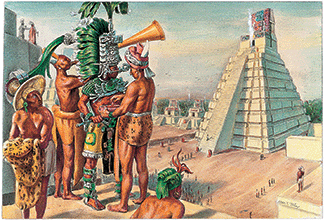MAYAN CIVILISATION
1.Context
Mexican President Andrés Manuel Lopez Obrador (also known as AMLO) became the subject of internet jokes on Sunday (February 26) when he claimed a blurry, dark photo of a tree at night showed a figure from Mayan mythology, as depicted in a historic sculpture from the Mayan civilization.
2.About Aluxes
According to Mayan mythology, aluxes are small, mischievous creatures that inhabit forests and fields and play tricks on people, like hiding things
Shelter-like structures were built for aluxes when construction works were undertaken in the area
It was believed these shelters would attract the creatures, who would then help ward off any hindrances and help work proceed smoothly
Similarly, there are myths about angering the forest spirits
3.About Mayan Civilisation
- The larger Mayan civilisation (which reached its zenith between 300 AD to 900 AD) is recognised as one having significant cultural heft in its time with innovations in farming, stone architecture, the study of mathematics and astronomy, devising calendars, as well as large-scale human sacrifices as part of religious rituals
- It spanned present-day Mexico, Honduras and Guatemala in Central America.
- Yucata, a peninsula in Mexico on the Gulf of Mexico, has important Mayan sites
- Mayan people, to date, continue inhabiting some of these regions
- Though the number of people speaking the indigenous languages and following traditional customs has fallen over time with Spanish colonisation or the post-Hispanic period


- As early as 1500 BCE the Maya had settled in villages and had developed an agriculture based on the cultivation of corn (maize), beans, and squash; by 600 CE cassava (sweet manioc) was also grown.
- They began to build ceremonial centres, and by 200 CE these had developed into cities containing temples, pyramids, palaces, courts for playing ball, and plazas.
- The ancient Maya quarried immense quantities of building stone (usually limestone), which they cut by using harder stones such as chert.
- They practiced mainly slash-and-burn agriculture, but they used advanced techniques of irrigation and terracing.
- They also developed a system of hieroglyphic writing and highly sophisticated calendrical and astronomical systems.
- The Maya made paper from the inner bark of wild fig trees and wrote their hieroglyphs on books made from this paper.
- Those books are called codices. The Maya also developed an elaborate and beautiful tradition of sculpture and relief carving.
- Architectural works and stone inscriptions and reliefs are the chief sources of knowledge about the early Maya.
- Early Mayan culture showed the influence of the earlier Olmec civilization.
- The rise of the Maya began about 250 CE, and what is known to archaeologists as the Classic Period of Mayan culture lasted until about 900 CE. At its height, Mayan civilization consisted of more than 40 cities, each with a population between 5,000 and 50,000.
3.1.Indigenous People
President AMLO has been known to emphasise aspects of indigenous culture
Lopez Obrador(Mexican President) has often spoken about the pre-colonisation culture and blamed colonial-era abuses for present-day injustices in the country.
The 1,500-kilometer Maya Train line is meant to run in a rough loop around the Yucatan Peninsula, connecting beach resorts and archaeological sites, AP reported. It has come under criticism for damage to the environment and potentially hurting the archaeological sites
Source: Britanica, indianexpress




